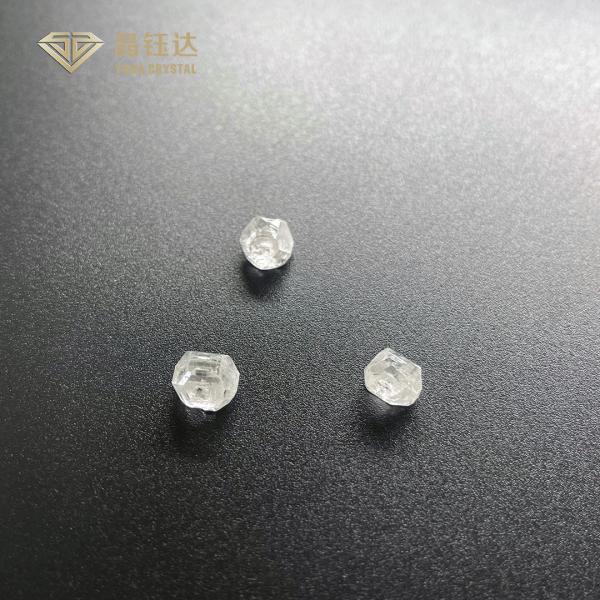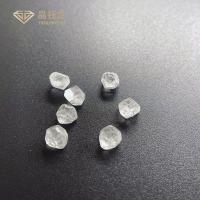VS-SI Mix Clarity D-F Color 8.0-10.0ct Lab Grown Diamond Hpht For
Big Sizes Lab Diamond Rings Making
Lab Grown Rough Diamonds Description
You may have heard that diamonds come from coal. In fact, it takes
3.3 billion years for diamonds to form in a specific area 90 miles
below the earth's crust. This process requires a very high
temperature, at least 2000 degrees Fahrenheit. Although it is
impossible to accelerate the organic process of diamond formation
on earth, you can copy the environment and conditions, and then
accelerate the process of diamond formation. That's how synthetic
diamonds are made in the laboratory. They are not synthetic
diamonds because they have all the characteristics of diamonds,
including chemical composition and molecular structure.
Diamonds produced in the laboratory have different names, including
culture diamond, engineering diamond, synthetic diamond and
synthetic diamond. Diamond planting technology was first
established in 1955, when the first laboratory grown diamond in
history was made. Under the same chemical composition, the
laboratory grown diamonds have the same appearance and hardness as
natural diamonds. However, it was not until the late 1980s that the
quality of diamonds produced in the laboratory improved that the
technology developed to today's level.
Parameters of Lab Grown Rough Diamonds
| HPHT Lab Grown Diamonds Details |
| Brand Name | Yuda Crystal |
| Name | Rough Lab Grown Diamonds |
| Diamond Color | D-F |
| Diamond Clarity | VS-SI |
| Diamond Carat Weight | 8-10 carat |
| Diamond Cut | Uncut |
| Technology | HPHT |
| Size | 5.0-7.0mm |
| Shape | Raw |
| Application | For Cutting Lab Grown Loose Diamonds |
| Place Of Origin | Zhengzhou, China |
| Delivery Time | 1 - 15 Working Days Base on Order Quantity |
| Payment Terms | 100% Payment In Advance |
| Payment Methods | T/T, PayPal, Western Union, Bank Transfer |
| Shipping way | DHL, FedEx, SF Express, UPS, EMS, TNT etc |
| M.O.Q | Negotiable |
| Diamond Type | Synthetic(lab created) |
| Location | Zhengzhou, China |
| Treatments Applied | None |
| Fire Dispersion | 0.044(Same as Natural Diamond) |
| Brilliance Refraction Index | 2.42(Same as Natural Diamond) |
| Relative Density | 3.52(Same as Natural Diamond) |
| Chemical Composition | Carbon(Same as Natural Diamond) |
| Moh's Hardness | 10(Same as Natural Diamond) |
Lab Grown Rough Diamonds Introduction
HPHT is the abbreviation for high temperature and high pressure
treatment, and its purpose is to change or improve the natural body
color of certain types of diamonds to make them more valuable.
In the past, it was called Pegasus diamond and GE POL diamond. The
reason why it is called GE Diamond is because The technology
developed by GE in the United States is a new product exclusively
sold by POL, a subsidiary of Israel's LKI, in 1999.
HPHT technology is to process natural diamonds at high temperature
and high pressure to enhance the color grade of diamonds. In one
move, it can be upgraded to 4-6 levels. However, not every diamond
can be processed by this technology. It must have a J color or
higher, and be free of impurities and high-clarity quality. During
processing, the results cannot be predicted. In other words, it is
not certain what level it can be promoted to.
At the same time, diamonds treated with HPHT may deepen or change
in color to become a colored diamond.
Natural diamonds are created by nature and are the result of high
temperature and pressure formed over billions of years. The Rough
Lab Grown Diamonds are produced in the laboratory, usually in a few
weeks. The chemical difference between the two is same.
So how do you distinguish between Rough Lab Grown Diamonds and
natural diamonds?
There is no obvious difference between the Rough Lab Grown Diamonds
and natural diamonds. Even professional gemologists need special
equipment to identify them. By zooming in, professionals will be
able to discern subtle contrasts in diamond inclusions grown and
mined in the laboratory.
| The Difference Between Lab Diamond And Natural Diamond |
| Properties | Earth Mined | Lab Created |
| Guaranteed Conflict-Free | No | Yes |
| Hardness (MOHS) | 10 | 10 |
| SP3 Carbon Diamond Bonds (%) | 100% | 100% |
| Internal Crystal Structure | Face-Centered Cubic | Face-Centered Cubic |
| Hardness Comparable | 2.42 | 2.42 |
| Relative Diversity | 3.52 | 3.52 |
| Color Diffusion | 0.044 | 0.044 |
| Color | Various Grades | K to D grades |
| Price | $$$$$ | $$$ |
Lab Grown Rough Diamonds Details












